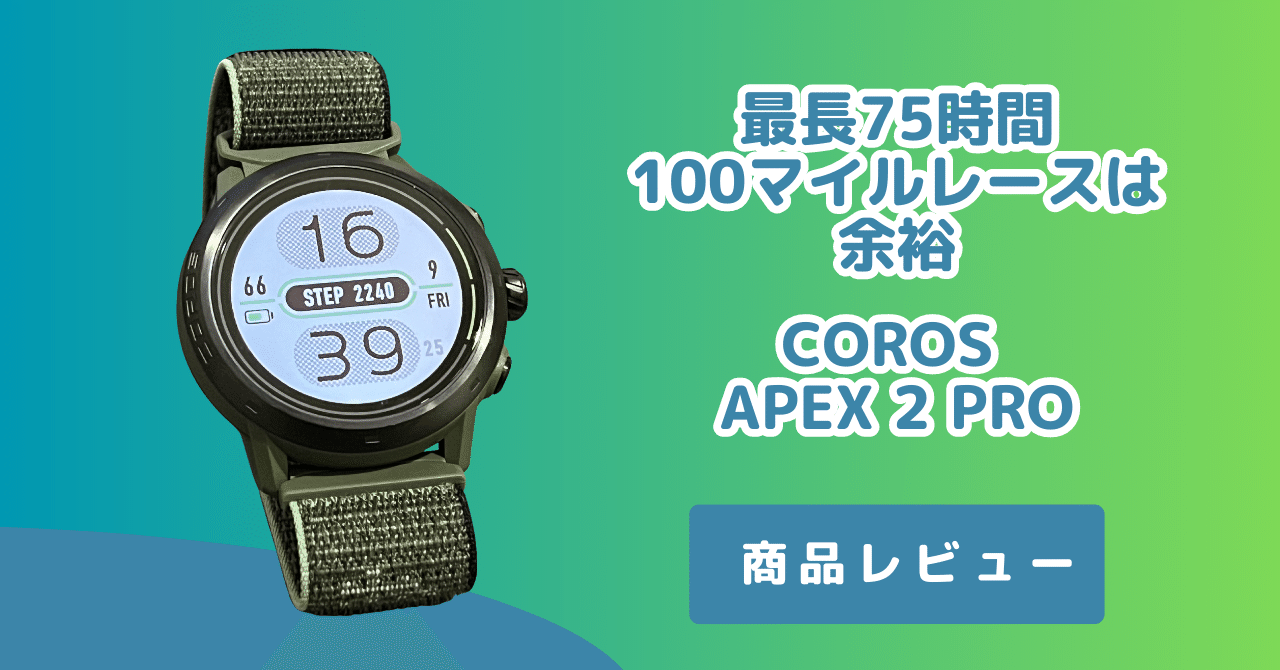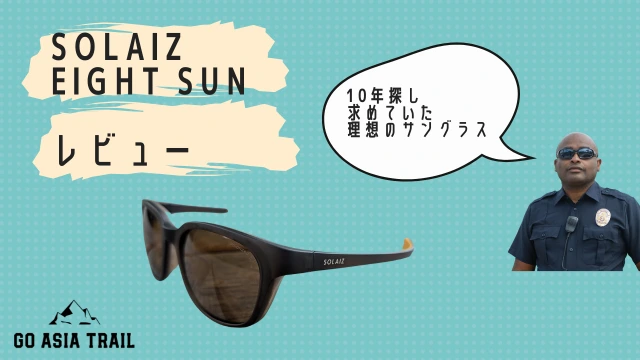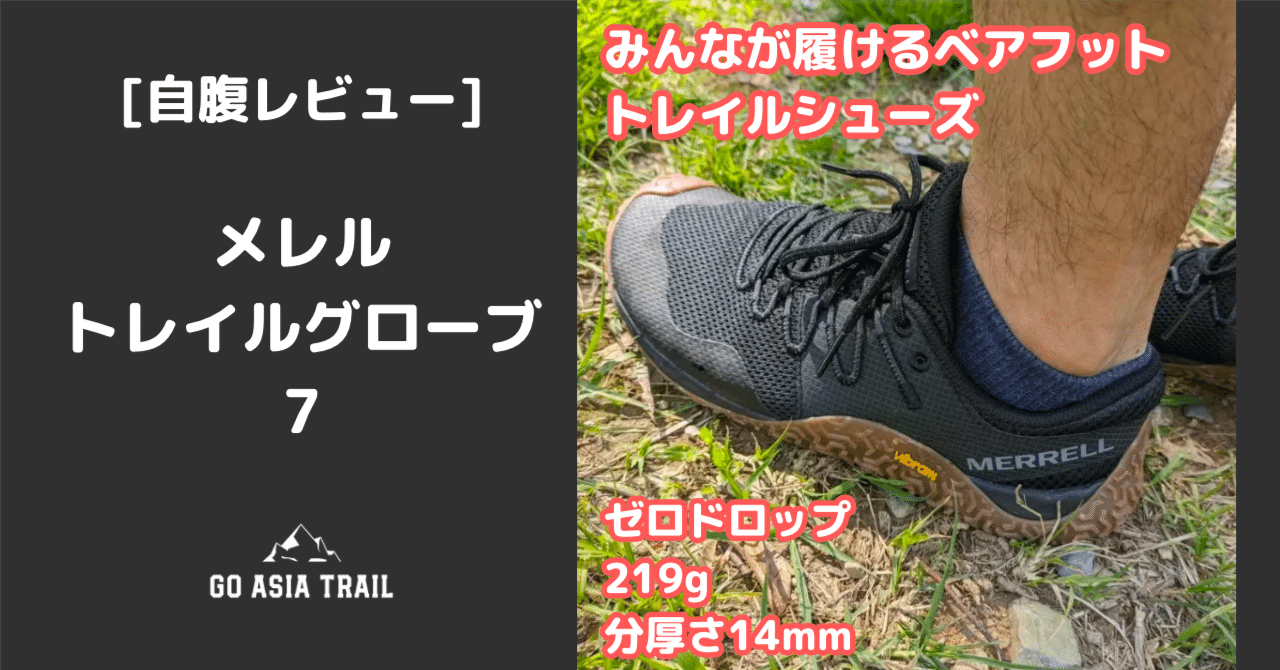When it comes to runners and trail runners, I believe that a GPS watch is one of the indispensable items. My first GPS watch was a Garmin Forerunner series. After that, I used the Suunto Ambit, EPSON's Wristable GPS for Trek, and for the past 3-4 years, I have been using a GPS watch made by Amazfit, a Chinese smartwatch brand, because of its cost-effectiveness.
I have been using several brands and models for more than 10 years, and I have decided to buy a new GPS watch from COROS in 2022. The model is called "COROS APEX 2 PRO" and it was launched globally in November 2022. I was very excited to buy it because it is the first time in a long time that the brand is changing. Different brands have different usability and different software worldviews.
COROS is a Chinese company founded in Shenzhen, China in 2014, which started out by raising funds through crowdfunding to develop a smart helmet (for bicycles). Then in 2018, the company released its first GPS watch. It has since grown into a brand favored by the world's top athletes, including the world's Kilian Jornet and the world record holder in full marathon, Eliud Kipchoge.
Now, I would like to share my impressions of the COROS APEX 2 PRO that I purchased this time after using it for about 2 months for both daily training and daily life.
COROS APEX 2 PRO Product Overview
COROS has three series: PACE (for road running), VERTIX (for mountain climbing), and APEX (for trail running).
The APEX 2 PRO is the second generation of the APEX series and is available in standard and PRO models, with the PRO model offering better GPS accuracy and a longer battery life than the standard model. Because of the larger battery capacity, the PRO model weighs a little more (42 g (standard), 53 g (with nylon band)). Other than that, there are no functional differences.
Battery life is the biggest concern for trail runners, but the APEX 2 PRO has a maximum of 75 hours (standard full GPS mode). If you change the GPS mode to a more accurate one, it can last up to 45 hours or 26 hours, but I think the standard full GPS mode is usually sufficient. At any rate, I think the capacity will be sufficient for a 100-mile race or so.
Another feature that could be used in everyday life is the ability to connect to a smartphone via Bluetooth and have the watch vibrate with notifications from incoming calls and apps. In the past, GPS watches for sports did not have this kind of functionality, but perhaps because smartwatches such as the Apple Watch and Pixel Watch have become so popular recently, this kind of functionality is now being implemented.
The APEX 2 PRO is priced at 73,700 yen (including tax), which is quite reasonable considering that the top-end models from Garmin and Sunnto, as well as Apple's recently released Apple Watch Ultra, cost over 100,000 yen.
Impressions after using it
I have been using Aamzfit, a Chinese manufacturer, for many years, so this is only half a comparison with that product, but my impressions are as follows.
The nylon band fits great on my arm.
The crown (the spinning dial on the right side of the watch) is easy to use even with gloves on
The heart rate monitor is very accurate
The smartphone app is very well made and data analysis can be done with it alone
The clock is always on, which is very convenient due to the LCD
GPX data can be imported to check the route on the watch
Can freely change the layout and indicators you want to display during exercise.
Connection with Blutooth sometimes fails, probably due to energy-saving design
Connectivity with Insta 360 Go2 to control video recording and playback from the watch
When I first held the Coros Apex 2 Pro in my hands, I was amazed at the quality of the watch.
Amazfit's watches are cheap and good, but they are not as solid as some of their competitors, perhaps due to cost cutting... I have not touched the recent Suunto or Garmin watches, so I cannot compare them, but I thought the Coros Apex 2 Pro had a good quality feel. Of course, there are some resinous parts in places, but I think this is due to technical factors such as weight reduction and GPS signal acquisition. It is difficult to wear it in formal places, but I think it is sufficient for everyday use (I would wear it in formal places...).
Then there is the accuracy of the heart rate monitor. As a runner, I think managing training by heart rate is an important factor, and I don't want to compromise on the accuracy here! My impression is that the accuracy is clearly higher than that of the Chinese manufacturer, and the measurement is also more stable. I guess the optical sensor in the device is different between the 20,000 to 30,000 yen price and the 73,000 yen price. Although I have not compared it with the chest belt type, I think it records almost the same values as the sensory values.
Free choice of indicators during exercise
The layout of the indicators (distance, heart rate, elevation, time, etc.) during exercise can be freely changed from the smartphone application. This is quite convenient. During trail running, it is convenient to be able to see not only distance, time, and elapsed time, but also elevation and current heart rate on a single screen, so this is how I have it set up. Basically, I am using page 1 as a fixed page, and will customize the subsequent pages as I use them.
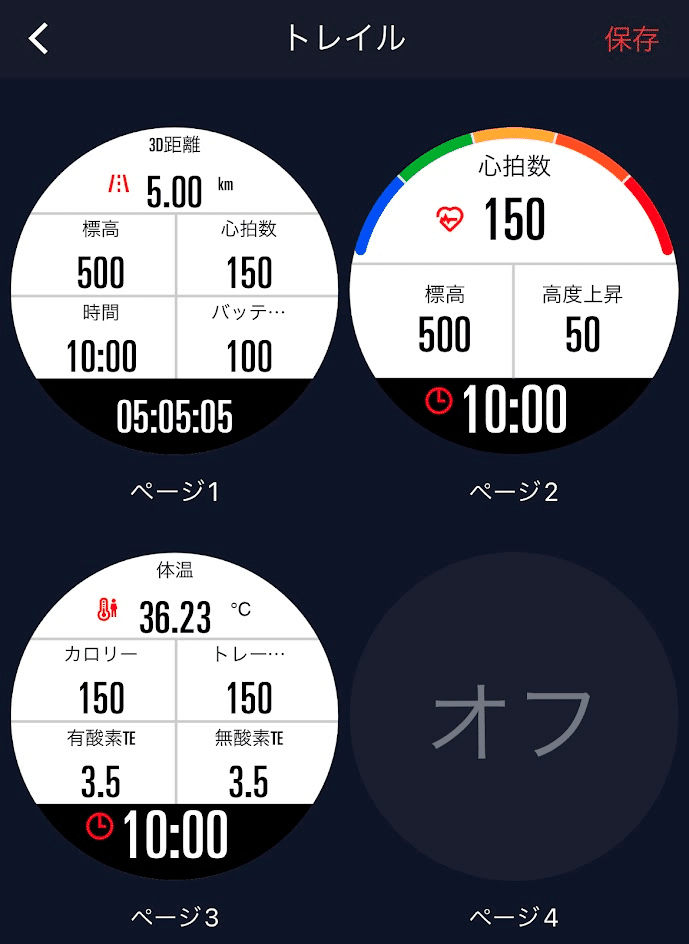
In Amazfit, this kind of functionality was not implemented, so the elevation and distance were not displayed on the same screen, and it was necessary to switch between them. With Coros, however, you can freely change the screen configuration, so you can choose the one that best suits your needs.
Navigation and elevation maps are a must during a race.
Recently, more and more race organizers are distributing GPX data, which can be imported into smartphones and GPX-compatible watches to ensure that you do not deviate from the course. With a smartphone, there is the hassle of having to unlock and view the data each time, but with a watch, there is the advantage of being able to check it immediately, albeit on a smaller screen.
Some of my previous Amazfit models had the ability to navigate using GPX data, but they did not have the ability to display elevation maps, and the Coros Apex 2 Pro can display elevation maps as well as navigate by map. This information is very useful during trail running races, as it makes it easier to plan pacing and refueling (and also serves as a tranquilizer) when you know how much more you have to climb to reach the summit and what the course will be like several tens of kilometers ahead.
Personally, I like that the elevation chart on the right side of the image is easy to read and allows me to see at a glance information such as, "On this course, I have to climb a cumulative total of 1,187 meters to get there, but how far I have climbed now. Also, since the current location is clearly displayed, you can see at a glance whether you need to climb further next time or whether a descent awaits you. Well done.
As for the navigation function shown in the left image, it is not as clear as on a smartphone, but you can see which direction you need to go, so you can check if you are going in the wrong direction or if your route has deviated too far.
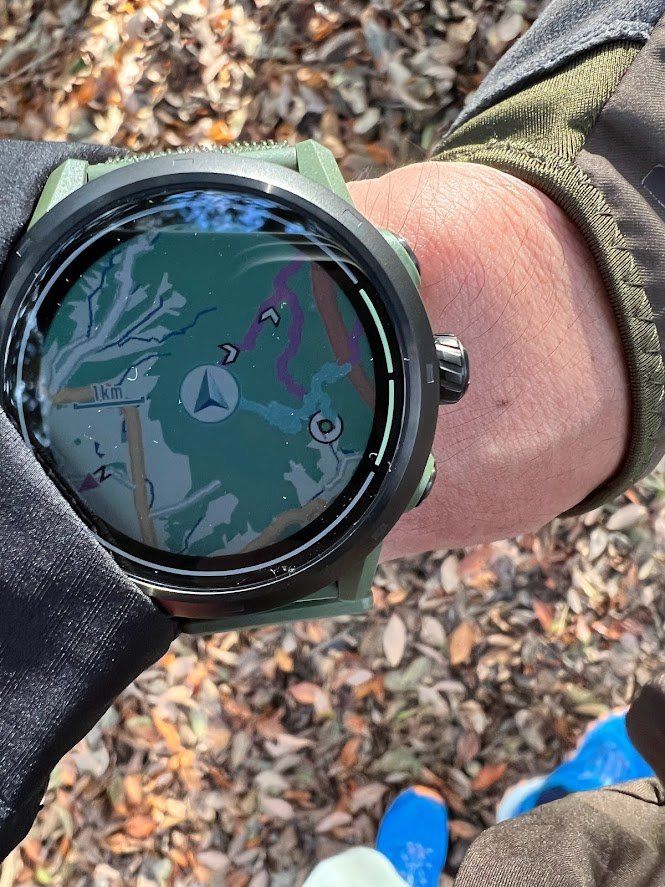
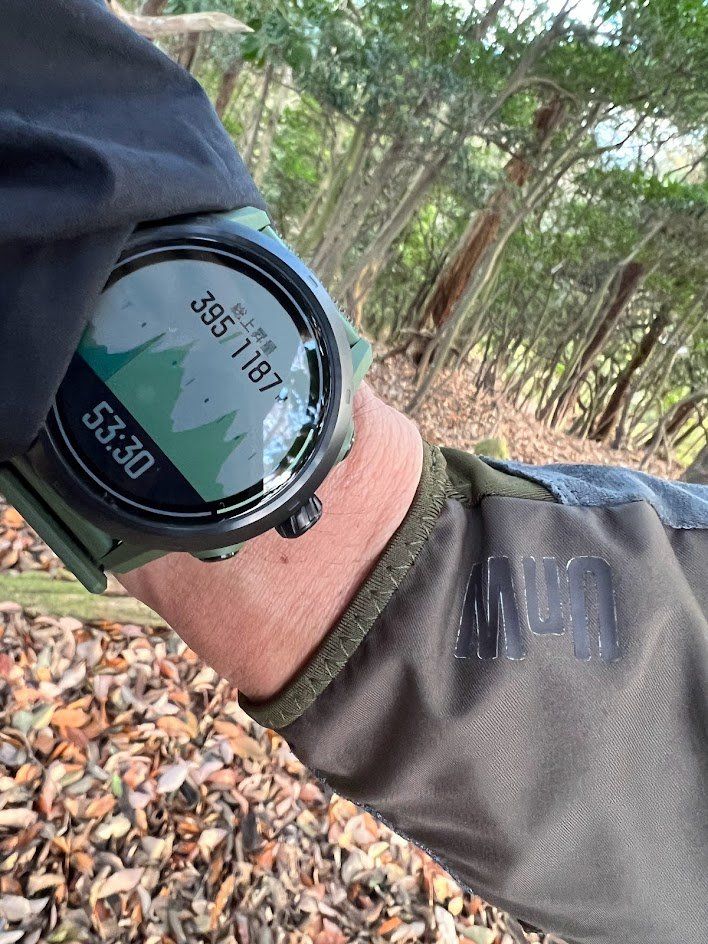
Battery life during continuous GPS measurement
Please refer to the actual measured data here.
At the start, the battery had 99% remaining and after 4 hours on the trail, it was down to 93%.
Outside temperature is 0~2 degrees Celsius
Standard full GPS mode, navigation function by GPX data is ON
Estimated continuous operating time is about 66 hours (catalog specs: up to 75 hours in standard full GPS mode)
We ran the trail in the middle of winter, which is a bit of a harsh environment for lithium-ion batteries, but an estimated 66 hours with the GPX navigation function turned on seems to be a sufficient specification. It is calculated to last at least 100 miles in a 100-mile race without needing to be recharged in the middle of the race.
The measurement results here were taken 3 weeks after purchase, so please note that the battery will go bad if used for a long time and will change depending on software updates and usage conditions, so please use this as a reference only.
Smartphone app build.
The Coros smartphone app, this is what impressed me the most about using it. Before I purchased the Coros, I had high expectations for it because of its reputation as a well-designed software, but I was really impressed with the quality of the apps.
I am sure that Garmin, Suunto, and other direct rivals to Coros have similar features, but I was not impressed by the scientific (or statistical?) metrics that are used to measure a runner's performance. I think it is very useful to be able to quantify a runner's performance and training with such scientific (statistical?) indicators to help maintain motivation and review training content. In addition, almost all of the help is available in Japanese, so I find it helpful in my training as it explains the indicators and how I can improve them.
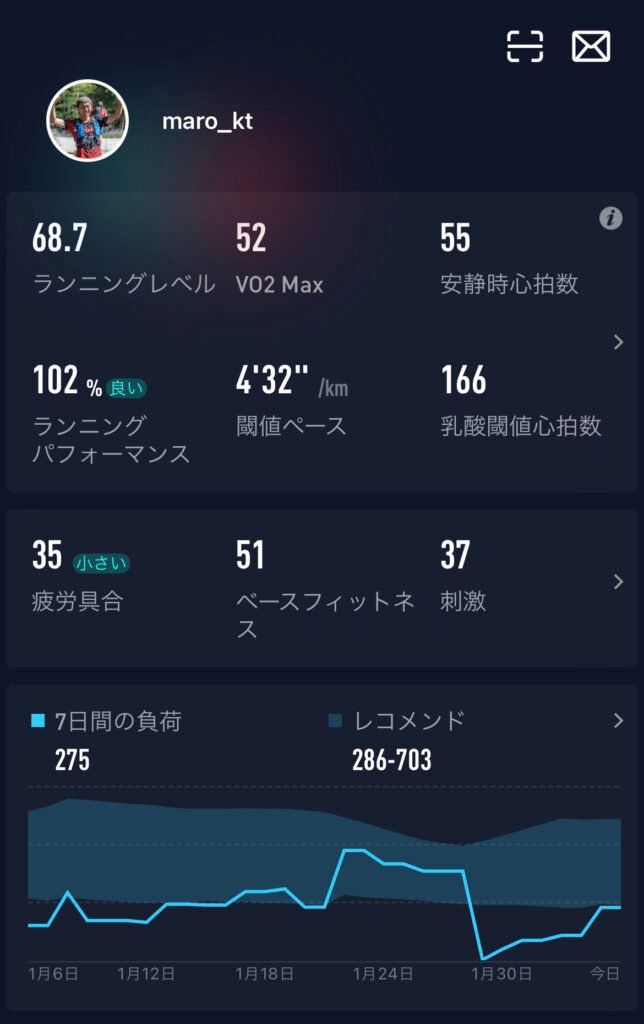
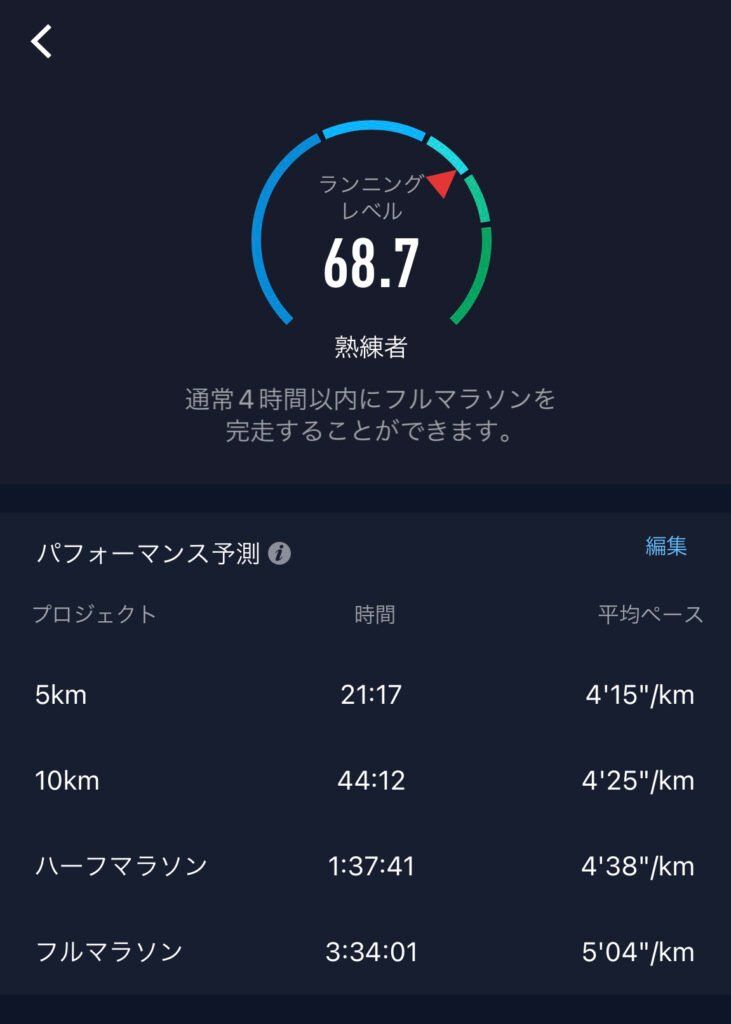
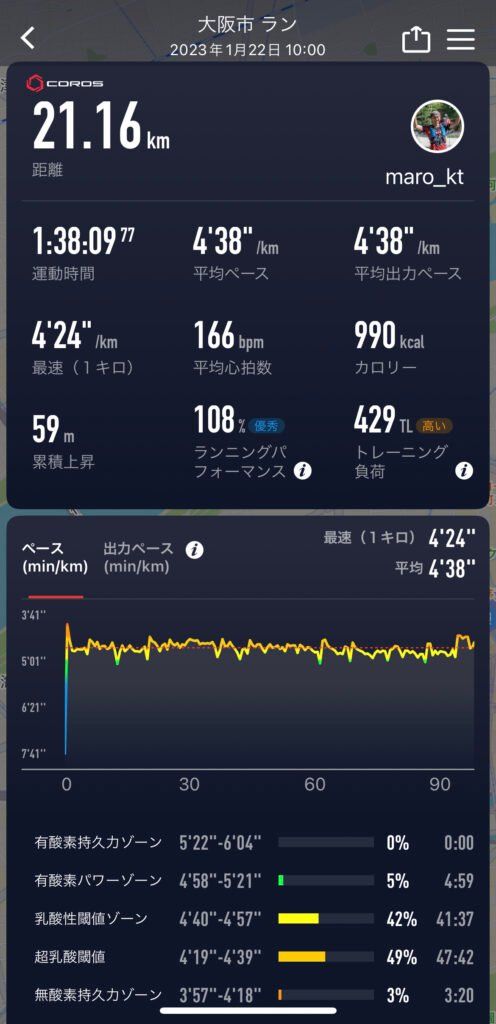
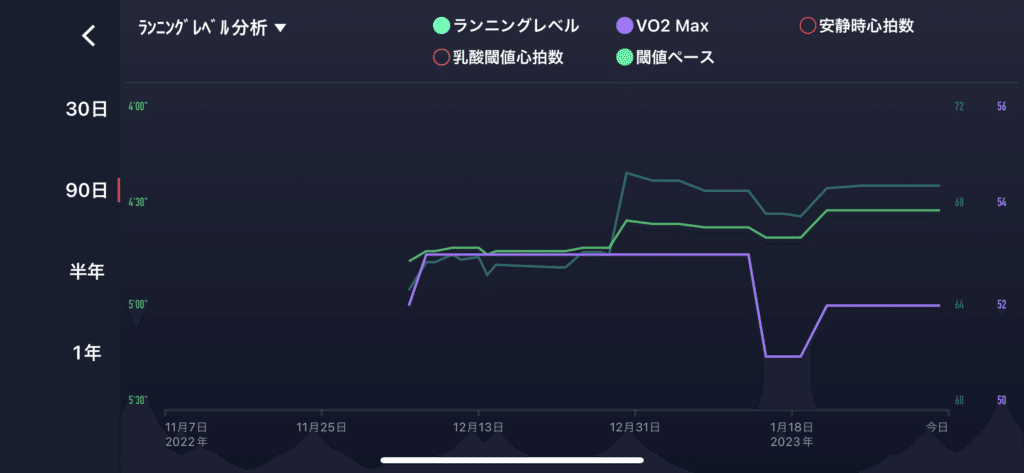
In particular, the running level indicators are very helpful to me, and I can check how much my level has improved through daily training and races, as well as my expected running ability for full marathons and half marathons. I think this helps me stay motivated.
I think it is great that these data can be used free of charge. From an engineer's point of view, the infrastructure for data analysis on the smartphone application side is also subject to a certain amount of cloud computing fees, but I think it would not be surprising if they would normally charge a few hundred yen per month. It is great that this is available free of charge.
Also, it supports Strava data integration, so Suunto and Garmin users can also use it.
What I would like to see improved
First of all, the notification function is different from Apple Watch and other sports watches made by Chinese manufacturers. This may be by design, as the main unit also shows an icon indicating that the Bluetooth connection is disconnected. I thought it would be nice to have a setting such as "always connected" in the settings.
Also, the sleep measurement and alarm function (alarm clock) are implemented, but I thought it would be nice to have a function like the Xiaomi Mi Band that vibrates when sleep is shallow. I tried to find out if it is possible to set this function, but it seems that this function is not available.
Conclusion
I feel that the Coros Apex 2 Pro is a good product to buy, and while GPS watches are getting more and more expensive as they get better and better every year, the Coros is priced a bit lower than the Garmin and Suunto watches, which is very reasonable. I also found the app to be well implemented and easy to use.
